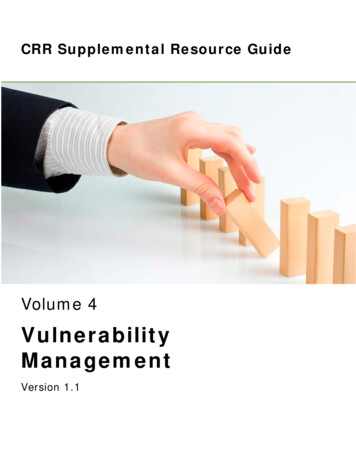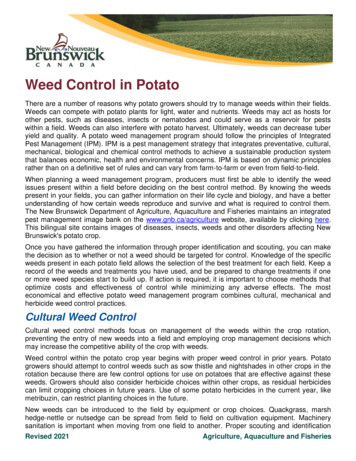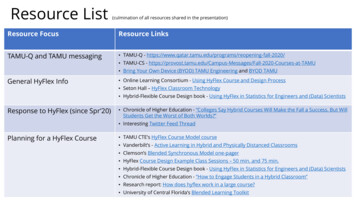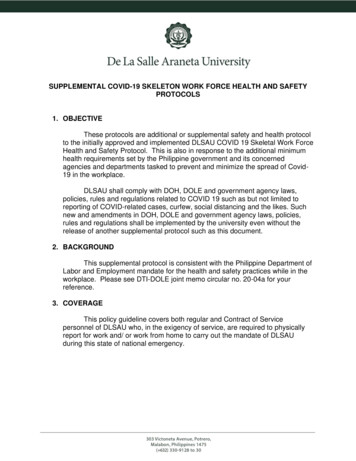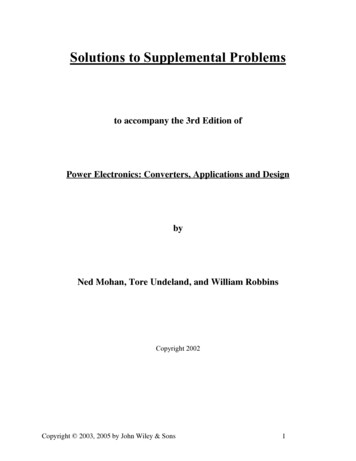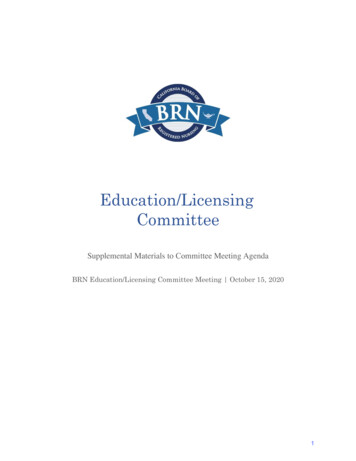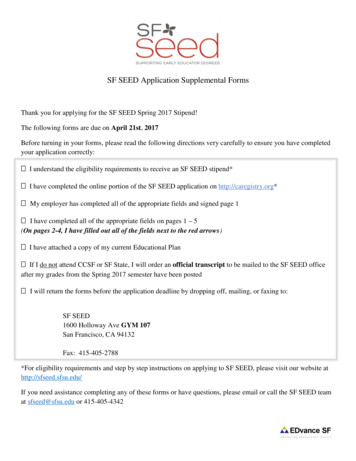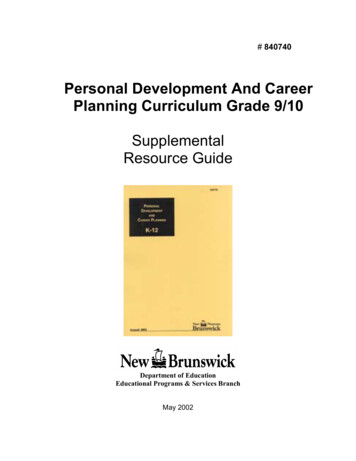
Transcription
# 840740Personal Development And CareerPlanning Curriculum Grade 9/10SupplementalResource GuideDepartment of EducationEducational Programs & Services BranchMay 2002
Part 1: The 7 Habits of Highly Effective Teenswww.fcpremier.comTeacher Note: The module on The 7 Habits of Highly Effective Teens is to becovered in a maximum of 12 hours. The Guidance Curriculum Development AdvisoryCommittee suggests the following activities from The 7 Habits of Highly EffectiveTeens, The Ultimate Success Guide for Teens Teacher Resource Guide. The 7Habits of Highly Effective Teens, The Ultimate Success Guide for Teens has notbeen included as it is a consumable product.The following icons are placed beside various lessons to indicate:Key Lesson: Homework Assignment: %%Optional Activity: TPortfolio Activity:2
Journal Writing options which may be utilized throughout the course: What are your good habits? What are your bad habits? How do you feelwhen you choose to exercise a bad habit? Describe yourself as if you were writing a letter of recommendation. Writeabout what you look like? What are some of your favourite lyrics? Why do lyrics speak to you? Write about a time when you were in a leadership position. Describe yourselfas a leader? Create a list of “7 Habits for a Highly Effective Me.”Note:Activities meet the following Personal Development and Career PlanningCurriculum, Grade 9/10 Outcomes; Outcome 1.1; demonstrate knowledge ofthe influence of a positive self-concept 1.2; communicate and interact positivelywith others; 1.3 demonstrate knowledge of the importance of individual growth foroneself and others; 1.4 demonstrate responsible choices concerning home,school and the community; 2.1 demonstrate responsible skills that lead a studentto become a lifelong learner; 2.2 demonstrate effective problem solving anddecision making skills for personal and educational purposes.Note:For additional communication activities refer to Career Studies 10, pages 84-93or Teacher’s Resource Career Studies 10, page121.Suggestion:The reading level of The 7 Habits of Highly Effective Teens is appropriate forgrade 9/10.Audio taped versions may assist struggling readers.3
Introduction to The 7 Habits (20 minutes) A. Have students write a definition for the word “habit” privately – on theirown. Divide the class into groups of 4-6 students, and have them sharetheir definitions within these groups and arrive at a group definition of“habit.” Have students read page 8 of The 7 Habits of Highly EffectiveTeens, “What exactly are habits?”B. Have students cross their arms. Now ask them to do it the other way.How does that feel? Who taught them this habit? How long would it taketo make them feel comfortable crossing their arms in this fashion? (Ittakes about a month to learn or unlearn habits.)C. Dr. Stephen Covey and his son, Sean Covey, have organized good habitsinto these seven categories:1. Be Proactive2. Begin with the End in Mind3. Put First Things First4. Think Win-Win5. Seek First to Understand, Then to be Understood6. Synergize7. Sharpen the SawHave students turn to page 5 of The 7 Habits of Highly Effective Teensand read and discuss each habit quickly.D. Have students list all the “good” habits they have acquired, and have themdiscuss these with a partner.E. Have students read The 7 Habits of Highly Defective Teens on page 7 ofThe 7 Habits of Highly Effective Teens and have them identify some of thebad habits they are practicing.Class Discussion:teens?What can students do to become more “effective”F. How can the “7 Habits” help? Have students turn to page 9 in The 7Habits of Highly Effective Teens and identify those habits they would liketo improve upon.“Always do what is right. This will surprise some people and astonish the rest.”Mark Twain4
Paradigms – Principles (40 minutes)A. Have students read the “Top 10 All Time Stupid Quotes” on pages 11-12of The 7 Habits of Highly Effective Teens.Discuss the impact –paradigm shift. Why are paradigm shifts important?B. Model-Building Activity (Note: Do it live or have a discussion.)If you put an airplane model together, what would you need? (Answer:Instructions.)What if the instructions were not for the airplane, but unknown to you,were actually instructions for a model train? What would happen if youattempted to assemble the model with these instructions? (Answer(s):You would become frustrated, you couldn’t do it, etc.)The same holds true for “paradigms”. Sometimes we have an incompleteparadigm of a situation.C. Have students read the “Paradigms of Life” on pages 18-23 of The 7Habits of Highly Effective Teens, and in groups of 4-6, discuss the benefitsand/or disadvantages of each paradigm listed.D. Have students turn to pages 24-27 in The 7 Habits of Highly EffectiveTeens and read. Ask students to list principles they want to use to build afirm character. %%“If we work upon marble, it will perish; if we work upon brass, time will efface it, ifwe rear temples, they will crumble into dust, but if we work upon immortal mindsand instill into them just principles, we are then engraving that upon tablets whichno time will efface, but will brighten and brighten to all eternity.” Daniel Webster5
The Personal Bank Account (20 minutes) (The amount of trust and confidence you have in yourself)A. Have students read the paragraph entitled, “The Personal Back Account” onpage 34 of The 7 Habits of Highly Teens.Keep Promises to YourselfHave students answer item 2 on page 45 of The 7 Habits of Highly Teens. Do Random Acts of ServiceHave students commit to acting on item 3 on page 45 of The 7 Habits ofHighly Teens. (Students could write their commitment in their agendas.) Tap Into Your TalentsHave students complete item 5 on page 45 of The 7 Habits of HighlyTeens. Be Gentle With YourselfHave students commit item 5 on page 46 of The 7 Habits of Highly Teens. Renew YourselfHave students commit to acting on item 9 on page 46 of The 7 Habits ofHighly Teens. Be HonestHave each student describe a time when he/she exaggerated orembellished a personal happening to a friend or parent. Was this honest?What was the outcome of the situation? B. In their agenda on today’s date, have students make a commitment tobecome more honest.“Never look down on anybody unless you’re helping them up.”JacksonJesse6
Habits Overview - Using the Tree Metaphor (20 minutes) A. Using the blackline master provided in The 7 Habits of Highly EffectiveTeens, The Ultimate Success Guide for Teens, Teacher Resource Guidefor Teachers (Appendix 3), make an overhead transparency of the 7Habits tree and go over the build-up of Habits 1 through 7.Have students turn to page 6 of The 7 Habits of Highly Teens and followalong. Tell them in advance that they will have to teach a partner theseven habits in the correct sequence.B. Have students teach each other, one at a time. Each student shouldexplain and complete the blanks on the “tree” diagram.C. Best Practices – The 7 Habits through ActionsThe following physical gestures emphasize each of the 7 Habits.Habit 1: Be Proactive. Place thumb to your chest.Habit 2: Begin with the End in Mind. (point to your feet) with the End(both hands point to the mountain top) in Mind (point to your head).Habit 3: Put First Things First.Habit 4: Think Win-Win. Think (point to your head) Win (hand-out, palmopen) Win (other hand out, palm open).Habit 5: Seek First to Understand, Then to Be Understood. Place handover your brow like you’re looking over the horizon, and then cup bothhands behind your ears.Habit 6: Synergize. Put your hands out toward opposite forearm andgrab your forearm. Then shake your arms up and down like a “mixer.”Habit 7: Sharpen the Saw. Pretend you are sawing a tree with yourhand.7
Be Proactive (Habit 1)(60 minutes)A. Explain “Reactive” model. Refer to page 49 of The 7 Habits of HighlyEffective Teens. Proactive people make choices based on principle. Reactive people make choices based on feelings, their moods, emotionsand impulse.In groups have students read scenes 1 and 2. Have them discuss each ofthe possible reactive and proactive choices and discuss the consequences ofeach choice.Have students read pages 51-65 and in groups identify 5 examples ofproactive people and 5 examples of proactive language.B. What is the significance of “Just Push Pause” on page 65 of The 7 Habits ofHighly Teens?Quote: “Between stimulus (action) and response, there is a space. It ispossible for us as individuals to develop this capacity to pause and give wiserresponses. The ability to do that comes from the development and use of ourunique human gifts.” Stephen CoveyC. Four Human Tools: This is a very important concept. Using this model,students can strengthen their proactive muscles. The 4 Tools are notseparate steps: they blend together into one.Have students read pages 66-68 of The 7 Habits of Highly Teens in groups of4-6 and discuss the “Four Human Tools”: self-awareness, conscience,imagination, and willpower. Allow them to compare and contrast these toolsin terms of human and animal behaviour.D. Optional Activity TWe can control only one thing . how we respond to what happens to us.Use the following example:Walk up to a student, (one who you know can take it!) who does not havegreen hair and tell him/her, “Hi, (name), I really like your green hair.” Watchthe reaction of this student and all other students. Debrief and have studentsdiscuss observed reactions.8
E. Optional Activity TPatty–CakeAsk for a student volunteer to come up to the front and stand in front of you.Ask him/her to raise his/her hands to mirror your own hand movements. Startmoving your hands and allow them to keep up with you and mirror yourmovements well. Ask how he/she felt. Next, wave your hands frantically.(The student will not be able to keep up). Stop and ask how the student felt.Usually they feel helpless, inadequate, discouraged, not in control, etc. Youwere reacting to my movements, you were being reactive. Now switch rolesand tell the student that you will mirror his/her hand movements. When youare able to keep up with him/her stop and ask how he/she feels. Usually theyare in control, feeling good, having power, etc. He/she was being proactive,calling the shots, being in control. Ask the student to again initiate handmovements. This time, stop and walk away from the student. Who was incontrol now? I was. I made the choice and walked away. How did (thestudent) look? Silly. You can make your own choices. Choose how you’regoing to act.Note:You can also relate this activity to resolving physical conflict.9
Begin with the End in Mind (Habit 2) (100 minutes)What does “Begin with the End in Mind” mean?Have students read the “Begin With the End in Mind” experience on page 75of The 7 Habits of Highly Teens.Have students read pages 76-84 and complete the “Who is my Hero”teaching activity (see Appendix 4, The 7 Habits of Highly Effective Teens,The Ultimate Success Guide for Teens, Teacher Resource Guide forTeachers.)ORHave students complete “What’s Important to Me? Teaching activity(see Appendix 5, The 7 Habits of Highly Effective Teens, The UltimateSuccess Guide for Teens, Teacher Resource Guide for Teachers.)Students should submit completed activity in their Linking to the Future:Career and Educational Portfolio.Have students answer the question: “Who is in control of your destiny?”(Answer: “I am!”)Discuss with students the pros and cons of this statement.The Great DiscoveryA. Have students write the scenario for this task:Five years from now, your local paper does a story about you and they wantto interview three people: a parent, a brother or sister, and a close friend.What would you want them to say about you?Note:You may want to use some background music as students progress throughthis exercise.B. Have students come to a conclusion about the important question: “Why do Ineed a mission statement?”10
Optional Activity TMission Statement Collage - (refer to pages 90-94 of The 7 Habits of HighlyEffective Teens)This is a good follow-up activity to the Great Discovery Section.Ask students to cut and paste pictures and/or words from magazines. Thiscollage will state what they are about, what they value.Optional Activity TPuzzle Activity - Divide students into two groups. Ask Group A to puzzletogether. (Do not show them the front cover.) How did it go? Now haveGroup B complete the same puzzle, this time with the front cover in front ofthem. How did it go? When you have an “End in Mind”, the goal becomeseasier to attain.Goal Setting - refer to pages 94-103A. Guide students through the “Let’s get S.M.A.R.T.” teaching activity (seeAppendix 6, The 7 Habits of Highly Effective Teens, The Ultimate SuccessGuide for Teens, Teacher Resource Guide.B. Achieving academic success means practicing goal setting every day! Guidestudents through the “Achieving Academic Success” teaching activity (seeAppendix 7, The 7 Habits of Highly Effective Teens, The Ultimate SuccessGuide for Teens, Teacher Resource Guide)ORHave students turn to the Academic Achievement pages in their agendas andset goals in each of their subject areas (if they have not already done so).Have them record results as test scores and other marks become available.Are the results in line with the goals set? This is one aspect of using Habit 2to become highly effective academically.C. Guide students through the “Weekly Goals” teaching activity (see Appendix 8,The 7 Habits of Highly Effective Teens, The Ultimate Success Guide forTeens, Teacher Resource Guide.) Encourage them to add a personal goal,such as becoming more proactive.D. S.M.A.R.T.’s good, but it’s important to be W.I.S.E., too. Guide studentsthrough the W.I.S.E. teaching activity (see Appendix 9, The 7 Habits of HighlyEffective Teens, The Ultimate Success Guide for Teens, Teacher ResourceGuide % ) and11
Put First Things First (Habit 3) (40 minutes)Getting OrganizedA. Balloon Activity (5 minutes) Materials required: Balloons and string.1. Ask for a volunteer and announce that the purpose of the next activityis to see how students handle the stress of student life.2. Invite a handful of volunteers to come up and toss a balloon at the firstvolunteer. Students announce what their balloons represent as theytoss them. The first volunteer must keep all of the balloons off of thefloor without using the strings. Allow six or seven balloons to beidentified and get tossed for the exercise.3. When the point is made that all of the balloons cannot stay off the floorat once, debrief. Discuss how your volunteer felt and what challengesthe juggling of the balloons presented.4. Gather the balloons and pull the strings through an agenda until all theballoons are “in control”.Explain to the students that by using their agendas they will be betterable to gain control over these stressors – the things that demand theirtime. Ask students to think about the practicality of agendas in greaterdetail, and to try to see how they can help organize their school work –and the rest of their life.B. Have each student privately answer, “What is stress?” Have them sharetheir definitions in groups of 4-6 and then arrive at a group definition ofstress. Have them place their group definitions on a flipchart and post thecharts on the wall. Guide students through the process of arriving at aclass definition of stress.C. In class, allow students to give suggestions for reducing some of thestressors they mentioned.Guide students toward becoming moreorganized with their agendas.D. Optional Activity TIssue the “Planning the Big Picture” teaching activity (refer to Appendix 10,The 7 Habits of Highly Effective Teens, The Ultimate Success Guide forTeens, Teacher Resource Guide) and discuss the six steps and how eachstep is linked to the planning tool. Forewarn students that you will havethem work on this “Big Picture Plan” after Module 10.E. Optional Activity TFirst Things First ActivityThis activity gives students a tangible example of putting first things first.Prepare a group of activities and place in container. Have students put“First Things First,” in accordance to what the activity suggests. For12
example, line up according to your date of birth, shoe size, height, lettersin your name, etc. Students begin to internalize what it means to put firstthings first.Understanding Time Management – refer to pages 106-112A. Have students study the “Time Quadrants” and the listed activities in thequadrants on page 107 of The 7 Habits of Highly Teens. Discuss thesignificance of the matrix and have students identify which quadrants theyoperate in most of the time.Have students define: What is urgent? What is important?Have students work in groups of four to determine what the results will be,in terms of stress, if a person operates mostly in: Quadrant 1 Quadrant 3 Quadrant 4 Quadrant 2What does each group recommend to combat stress? Allow students toreport.Highly effective teens spend as much time as possible in Quadrants 1 and2. They eliminate or reduce Quadrant 3 and 4 activities.B. Homework Assignment: %%Issue a copy of the “Planning for Improvement” teaching activity (seeAppendix 12, The 7 Habits of Highly Effective Teens, The UltimateSuccess Guide for Teens, Teacher Resource Guide.) Have studentscomplete column A privately, then complete columns B and C. Have themset a S.M.A.R.T. goal in their agenda to encourage them to become moreeffective.C. Optional Activity TTime QuadrantsThis activity is used to demonstrate what each quadrant representsthrough action.Quadrant 1 – Urgent and Important. Have this person jogging on the spotor in circles, running to important and urgent activities.Quadrant 2 – Not Urgent but Important. Have this person sit in acomfortable chair, offer them a soda, and give them a book or headsetwith some music.Quadrant 3 – Not Urgent and Important. (This is a quadrant of deception.The word urgent makes us believe that these activities are important aswell.) Ask a student to hold some object, with their arm straight out. Itappears simple enough to accomplish; however, over time, this activity13
becomes tiring and difficult. Similar to Quadrant 3 activities, this activitydoes not appear difficult; however, they do weigh you down over time.Quadrant 4 – Not Urgent and Not Important. Give student a Kush ball.Ask them to play with the ball. After awhile it becomes somewhat boringfor the student.D. Optional Activity: TPractical Planning Project (refer to pages 112-127) of The 7 Habits ofHighly Effective Teens. Solicit from the students their most effective waysof recording, prioritizing, and scheduling daily and weekly in their agendasand have them illustrate to their peers.14
Think Win-Win (Habit 4) (40 Minutes)A. After reading pages 146-154, have students discuss what this statementmeans, The “Private Victory” is the foundation for thinking Win-Win!“Think Win-Win” is the foundation for getting along with others. Havestudents suggest why this is so, (e.g. it only takes one person to think WinWin.)B. Tic-Tac-Toe ActivityHave students pair up and create a 5 x 5 inch grid. Tell them the object of thegame is getting four X’s or four O’s in a row, vertically, horizontally, ordiagonally, and that one point will be awarded for each group of four X’s orO’s. Don’t say, “You are going to play Tic-Tac-Toe;” instead ask them if theyremember the game: Tic-Tac-Toe.”If students think Win-Lose, they will not have many points. However, if theythink Win-Win, they can put an X and O in each space.Compare scores and have students arrive at the fact that Win-Win thinkinggives the best results.Discuss the effects and the type of relationship Win-Lose; Lose-Win creates.Discuss Win-Win. Have students generate disadvantages on one list andbenefits on another list as someone copies the suggestions. Which list islonger? Discuss the effects of Win-Win as well as the type of relationship thismode creates.ORTrust is the Essence of Win-Win“Make A Fist” ActivityIt is important to set this up quickly, as you are trying to script the participants.Get everyone into pairs, and say, “One of you needs to make a very tight fist.”Demonstrate this fist by holding up your hand in the tightest fist you canmake. “I want the other partner - on the count of three – to try to open theother person’s hand.”“Ready? One .two .three Go!”Be prepared to share what happened when they conclude. Laugh with themand enjoy the moment. It is usually a good energizer!15
C. Think Win-WinDebrief the exercise with the following question and discussion.“Did any of you ask the other person to simply open his or her hand?” Theremay be one or two groups that did, but usually the majority will not have.“Why not? I know it isn’t fair; I admit I did script you: “Make a tightfist .ready, one two.three, go!” This was intentional.“When the environment feels competitive we often will automatically play WinLose. Yet, we just finished discussing Think Win-Win. Due to the fact thatmany of us over the years have been scripted Win-Lose, it is easy to fall backinto learned Win-Lose behaviours when the stimulus feels competitive. Ourparadigms govern our behaviours.”D. Optional Activity TCompetition is healthy when you compete against yourself, or when itchallenges you to reach and stretch and become your best. Be the Best YouCan Be!Have students return to their discussion groups and have them:1. Discuss this statement.2. Pretend that they are members of a school team and discuss thestatement again.3. Report back to the class.E. Have students read “The Fruits of Win-Win Spirit” on page 159 of The 7Habits of Highly Effective Teens, then make up scenarios which depict WinWin or No Deal and act these out in front of the class.16
Seek First to Understand, Then to be Understood (Habit 5)( 60 minutes)A. “Goldilocks and the Three Bears” ActivityAsk students to form pairs. Have them recite the story of “Goldilocks and theThree Bears.” However, they must alternate each word, for example:Person One: “Once”Person Two: “upon”Person One: “a”Person Two: “time”Allow 4-5 minutes for them to share the story. Debrief the group. Moststudents will feel frustrated that their partner did not know the story. “Whenwe listen to someone sincerely, we listen to that person from his or her frameof reference.”B. Repeat the same activity with four partners. Share feelings.C. Have students read the poem, “Please Listen” on page 167 of The 7 Habits ofHighly Effective Teens.Have them discuss, in small groups, theirexperiences in reference to this poem.D. Have students read pages 167-170. Discuss the five poor listening styles.Have students decide which listening style(s) they are struggling with andwhich one(s) they are going to practice un-doing for the next week. Havethem make a commitment with a partner who will agree to act as a coach.E. Have students read pages 171-179. Have students refer to the“Communication Problems with my Girlfriend: scenario on page 176 of The 7Habits of Highly Effective Teens.” Have them discuss in pairs if they canrelate to this issue, and, if so, what they have done to overcome this issue,and, if not, what they would do to overcome it.ORDiscuss the “Three Keys to Genuine Listening”: (pages 171-176)1. Listen with your eyes and your heart (acknowledge the other person’semotions – not what that person is saying, but how he or she is sayingit.)2. Stand in the other person’s shoes (listen from his or her point of view.)3. Practice mirroring. (See page 175 of The 7 Habits of Highly EffectiveTeens for examples of mirroring phrases.)17
F. Optional Activity T“Listening Role Play”Create a scene in which a student is upset. Have two chairs, one for theupset student, and the other to serve as a “revolving” chair. The person whosits in this chair will be listening genuinely. He or she will be using his or hereyes and heart – not trying to fix the situation, but instead being empathetic,and helping the other person feel understood. After the listener has had achance to respond once or twice, have a different student sit in the chair.Keep the role-play moving. Allow students to listen genuinely, as opposed toin a self-centered way.Have the students discuss what they have learned. Share ideas.18
Synergize (Habit 6) (60 minutes)Learn to Celebrate DifferencesHave students read pages 182-192. Issue the “Celebrating Differences” handout(see Appendix 14, The 7 Habits of Highly Effective Teens The Ultimate SuccessGuide for Teens Teacher Resource Guide). Discuss the statement, “We are all aminority of one” and have students complete the “Celebrate your Own Diversity”activity.Have students team up with a partner and share their findings. Do they agreewith their findings?ORGrapes, bananas, oranges, melons .Practice “synergizing” using the ThirdAlternative! Divide the class into even groups.Students are now aware of their natural abilities, how they learn best, theirtrouble areas, and how they can expand their style. (Note: Each group shouldhave approximately the same number of grapes, bananas, orange and melons.)Encourage the students to put their best foot forward in their group, and, as theywork together see if they can expand their style.Optional Activity TTask1. Each group is to organize a plan for a school fundraising event.2. Have them follow the guidelines, steps 1-12 as they formulate their “plan”(see Appendix 15, The 7 Habits of Highly Effective Teens, The UltimateSuccess Guide for Teens, Teacher Resource Guide.)Students present their plans next period.3. Students observe each plan, noting: Creativity Completeness Adherence to guidelines Practicality Ease of selling plan to school and staff and parents Evidence that plan is a team effort PresentationHave students think of a situation in which constructive feedback would reallyhelp another person. Encourage them to share this type of criticism with peoplewhen the time is right.19
Optional Activity TEach group is to report on their plan. The class uses the observation criteria asoutlined, noting especially if real synergy took place as each group looked for thebest solution. Discuss how synergy took place in each group.Optional Activity THave the entire class now synergize and come up with the very best solution forthis fundraising activity.Optional Activity THave the students ready the poem, “The Cold Within” on page 192 of The 7Habits of Highly Effective Teens and share their own experiences with “The ColdWithin.” Ask for suggestions for preventing and/or overcoming “The Cold Within”situations.Optional Activity TSynergy Glass ExercisePlace a glass in front of each participant. Ask participants to take out a blankpiece of paper and, working independently (without viewing anyone else’spaper), have them write down as many ideas as they can for using the glass.Time them for 60 seconds; then ask them to stop. Determine the averagenumber of ideas recorded per student.This time, ask participants to pair up with another person. Workingcooperatively, seeking to value the differences, ask students to come up withas many new ideas as possible. Allow them to get together with their partnerand compare answers from their first independent exercise, then start timingthem for the creation of their new ideas. Again, time them for 60 seconds,then ask them to stop.How many doubled ideas from the previous independent exercise? Howmany more than doubled when working with a partner? How many werecompletely surprised by an idea their partner had, and if they had an hour tothink, probably still would not have come up with that idea? How manyexperienced the “piggy-back” effect, which means their interaction with theirpartner caused them to come up with ideas they would not have without thediscussion with another person? This is the essence of the Third Alternative.Optional Activity TSynergy Wall HangingCreate a wall hanging displaying all of the 7 Habits. Independently, ask eachgroup of students to come up with a banner or flag that describes each habit.Then put all the habits together. This is an example of synergy, plus they canplace the final product on display.20
Sharpen the Saw (Habit 7) (120 minutes)It’s “Me” TimeA. Issue the “Lumberjack and Chain Saw” handout (see Appendix 17, The 7Habits of Highly Effective Teens, The Ultimate Success Guide for Teens,Teacher Resource Guide) and have a discussion on the merit of “keeping thesaw sharp.”Have students resolve the Challenge Activity on the handout, in groups offour.B. Have students read “Caring for your Body,” on pages 208-215 in The 7 Habitsof Highly Effective Teens. Have them decide what strikes their interest andwhich ideas they would be willing to follow up on. Have them makecommitments and arrange for follow-up sessions.C. Have students read “Caring for your Brain” on pages 216-227 of The 7 Habitsof Highly Effective Teens, and determine which ideas they like best and wouldbe willing to follow up on. Have them make commitments and arrange forfollow-up sessions.D. Have students read “Caring for your Heart” on pages 228-233 of The 7 Habitsof Highly Effective Teens and do the same identification and commitmentexercises as above.E. Have students read “Caring for your Soul” on pages 234-241 and repeat theabove activities once more.F. Have students discuss, in groups, obstacles in reference to each aspect of“Sharpen the Saw.”G. Have students work together to develop strategies to overcome the identifiedobstacles.Balance and Moderation in All ThingsA. Have students participate in the “Four Corners” activity to identify possible“Sharpen the Saw” goals.“Four Corners” Activity1. Write “Physical,” “Social/Emotional,” “Spiritual” and “Mental/Intellectual” onseparate flip chart pages. Place one chart in each of the four corners ofthe room. Divide the participants into four groups, and have each groupgather around one of the posted flip charts.21
2. Give each group thirty seconds to brainstorm and wri
A. Using the blackline master provided in The 7 Habits of Highly Effective Teens, The Ultimate Success Guide for Teens, Teacher Resource Guide for Teachers (Appendix 3), make an overhead transparency of the 7 Habits tree and go over the build-up of Habits 1 through 7. Have students turn to page 6 of The

